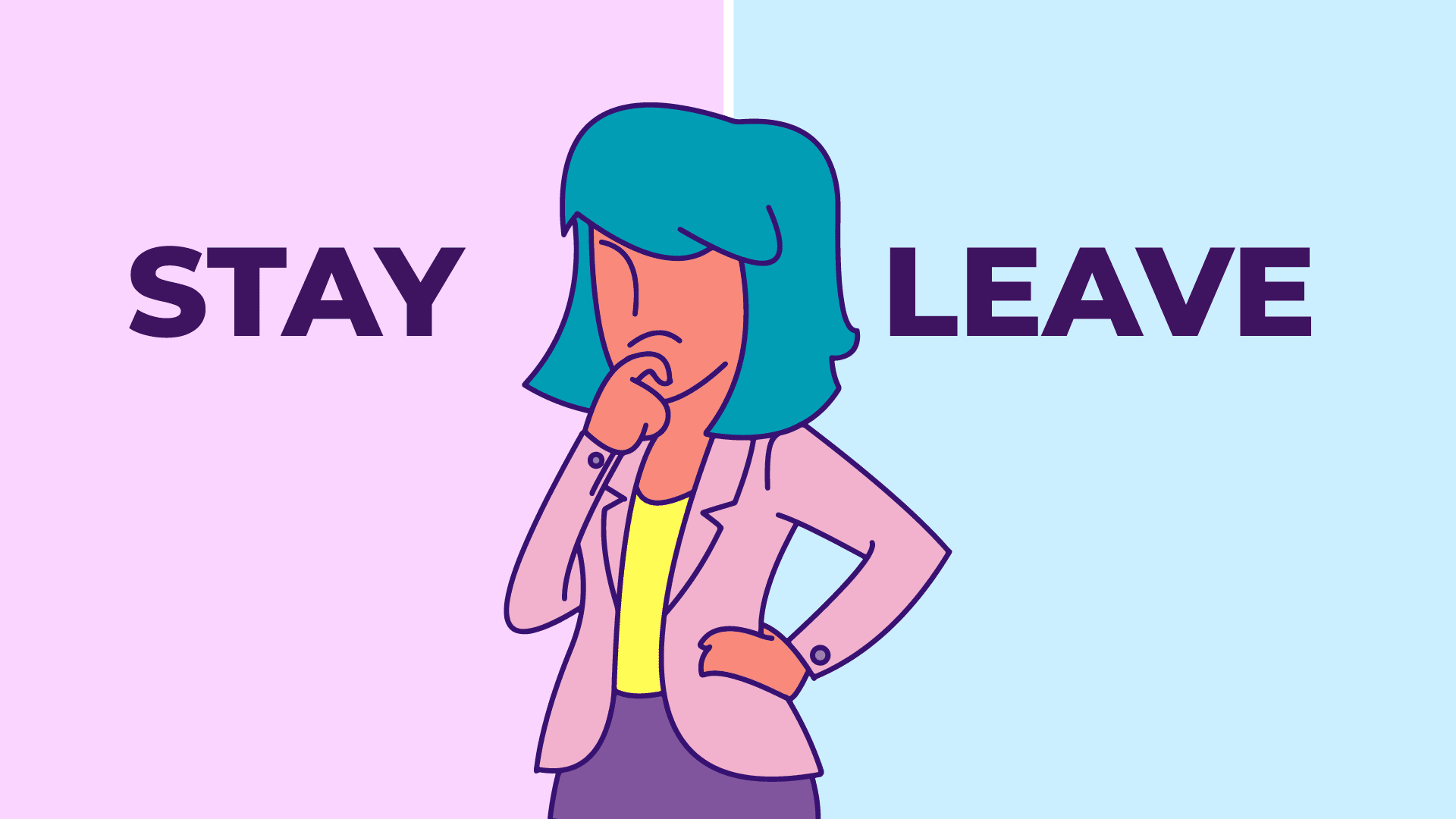SECTION
5 easy steps to avoid the Great Employee Resignation

Listen to this article:
The Great Resignation is a phenomenon that shows a record number of employees quitting their jobs. Why is this happening? Covid-19 forced everyone to switch to working remotely. When the pandemic started, the whole job market was filled with uncertainty, there were mass layoffs, and many people lost their jobs. Those who were lucky enough to remain employed lived in constant fear for their job security.
Once the curve started to recover, people gained courage and oriented themselves towards better options searching for more money, better social security, and medical insurance. According to the US Bureau of Labor Statistics and recent studies, the number of people leaving their job increased to a record-breaking 4.4 million in September 2021.
Categories most affected by The Great Resignation
Similar studies conducted by Visier show the highest affected categories when it comes to departing employees:
-
Mid-career workers aged between 30 and 45 show a 20% increase in resignation rates.
-
Younger employees between 20 and 25 years old used to be on top of the resignation statistics; recently, the rate decreased, similar to what happened to the 60-70 years old demographic.
-
Women resignations increased, most probably due to the side-effects of the pandemic, where they were forced to stay at home and take care of their children.
-
Manager resignations are visible only starting with September 2021.
-
Technology and healthcare companies recorded the greatest impact: employees transitioning from one company to another. Healthcare employees quit their jobs with an average of 3.6% increase as compared to the previous year. In tech companies, resignations increased by 4.5%.
Learn how to spot early signs of employees who are about to quit.
Managers and HR representatives shouldn’t panic. Employees exhibit warning signs when they are not happy or thinking about new opportunities. Utah State University investigated this behaviour and saw a few patterns that we extracted below:
-
Employee productivity is decreasing more than usual
-
Team members act less like team players and become more individualistic.
-
People are only doing the minimum work required.
-
They are less interested in pleasing their managers.
-
Colleagues are expressing dissatisfaction with the current job or manager.
-
Some people start leaving earlier from work or take sick leave more often.
-
They have less interest in working with customers than usual.
Deepasha Kakkar, Founder & CEO of Crackitt, helps us understand these patterns in employees who think about their last day of work.
If your employee rarely misses work but then starts calling in sick more frequently or just using up vacation days on a random basis, it could suggest they're disconnected at work, to the point where they're utilizing the time off to look for other work. Spending up all of their sick days and vacation time simultaneously could signify that they're about to leave and want to ensure they obtain all of the advantages they're entitled to.
Remote work is becoming the new norm, and people are mostly happy. To piece together a possible future, let’s see e most common reasons for employee departure.
Help your people to stay engaged with their job
Understand your employee's emotions before it's driving him negative thoughts, and help everyone stay aligned.
Switch to a friendly experience
Top 4 reasons employees think about a new job
-
The need to avoid burn-out and have a better work-life balance
-
A lack of clear company vision
-
Faulty work structure and not enough feedback
-
Looking for more recognition
We wanted to know the honest opinions of managers and decision-makers from companies worldwide addressing this problem. Here’s what they think:
Clyde Steuber, Marketing Manager at IFB - Independent Fashion Bloggers, adds:
Two signs might indicate that an employee has made - up his mind to leave their job. The first one is that the level of engagement. It shows that he is not engaged with work-related events as he used to be. The second sign is when the employee starts to move some of his stuff from the office…Things that he used to have in the office. This means that the employee is planning to move, and he is no more comfortable where he/she is. These signs can be detected by the direct supervisor of the employee. I would recommend identifying the challenges that the employee is facing at the early stages to work on what is bothering him/her.
The main problems that push the employee to resign are appreciation and work overload. If the employee is not feeling appreciated, he would lack the motivation to complete his/her tasks properly. He/She would also look for another job where he/she feels appreciated. Superiors tend to overload and allocate more tasks to staff members they trust. However, the employee might crack. He will decide to leave when he/she finds that his/her professional life and personal life are not balanced.
To avoid a resignation trend in your company, you have to ensure a psychologically safe environment at work. This would help your employees to speak up and share what is bothering them.
On the need of recognition, Deepasha Kakkar, Founder & CEO of Crackitt, adds:
Money or concrete external benefits aren't always the motivators. Why? Many people leave because they are underappreciated. Your employees, whether extroverts or introverts, enjoy receiving public or private appreciation. Rewarding your staff for their accomplishments is one approach to motivate them.
Also, stick to the job description; no one wants to undertake work that was not listed on their job description when they started. Give your co-workers a raise or incentives if they are truly needed to up their given tasks.
Remote work is here to stay.
People don't want to go back to the office.
Even though many companies have shown flexibility regarding working from home, quite a few organizations still force employees to return to the office without concern for the employees’ preference. This caused a lot of frustration and uncertainty.
Human resources representatives stated that new hires came with a focus shift towards higher levels of seniority to decrease the risk of losing new employees during onboarding periods without the benefit of hands-on training from existing workers.
Let's see how Todd Ramlin, Manager at Cable Compare, deals with “The Great Resignation”:
In my experience, people tend to signal they may be thinking about quitting before they do and being able to spot these signals gives employers a chance to act before it’s too late. Signs of someone considering resignation that I look for include a change in behaviour, more talk of being unhappy, less concern with pleasing supervisors, and less interaction with coworkers.
I think one of the best ways for companies to avoid the trend towards resignation is with data analysis. Consistently collecting and analyzing data on who quits and why allows companies to see what’s driving people to leave so that they can take steps to address the underlying issues.
Make your remote work easier with Mirro
Bring the office water cooler back. Make remote work feel like it's happening in the office with easier onboarding, a social activity feed, and constant interaction between your team members.
Keep your team connected
Employee resignation process - learn from it!
People will quit.
There are things you can do to understand better their reasons for leaving. Start running exit interviews. You can spot common patterns, close the collaboration on good terms and maybe gain a brand ambassador that could come back and bring others along.
Think about building a transition plan from former employees to new employees for a smooth process. A few steps recommended by the team of Lucidchart are shared below, together with a template you can use for offboarding.
-
Ask for a resignation letter with a notice of resignation from employees who leave.
-
Start working with their manager to find a possible new candidate
-
Send a notice to the IT department to know when it's time to disable the employee's accounts
-
Inform financial and legal departments regarding the employee's last day and their final pay and the closing of the employment contract
Harriet Chen, the co-founder of CocoFinder, helps us understand behavioral changes during the resignation decision:
When you notice your employees behaving unusually, it is the correct sign of an employee about to quit. The behavioural changes are less productive than usual performances, showing a lack of interest in work and pretending to work as a team. These changes lead to employee quit action in the future.
To overcome these issues, employers must take the correct measures to focus on the employee’s recognition system and spotlight their growth on time. Other than an HR team, the firm must create a separate Employee Welfare department to monitor employee retention in the long run.
Calculate employee retention rate
Coping with departing employees and understanding how your company should adapt occupies a lot of your attention. Don’t forget to take a step back once in a while and look at the numbers. It's critical to track both the problem and the impact, and the employee retention rate helps you understand this shift.
Harvard Business Review recommends the following formula to track the employee retention rate:
Number of Separations per Year ÷ Average Total Number of Employees = Turnover Rate
This way, you can correlate the impact of an employee's departure on your key business metrics.
On top of that, Maciej Kubiak, the Head of People at PhotoAiD, adds his personal experience on facing resignations and improving the company culture to avoid a few cases becoming a trend:
A person who wants to leave is mentally cut off from the workplace. As a result, you will notice an employees' decrease in team activities and work engagement. While productivity may still be high, the lack of innovative and proactive approaches indicates that employees are not inclined to stay.
Employees most often cite lack of motivation, feeling tired, and losing the work-life balance as their reasons to leave. All three can be summed up by one word: burnout. Employees probably strive to keep a healthy balance between work and personal life due to the remote working model. As a result, they do not get a chance to rest, so the workload finally overwhelms them.
Employers can address this issue by keeping track of their employees' well-being. A manager who constantly monitors employees' stress levels, sense of well-being, engagement, and work satisfaction can spot potential problems before they spiral out of control.
Avoid employee resignation by fostering a healthy company culture
If you wonder how successful companies fight The Great Resignation and empower their people to stay connected for a more extended period, here are a few tactics that you can study and apply in your organization, alongside examples from those who already faced the challenge.
Here are five easy steps that you can approach right now!
As an HR representative, I would like to tell you that there are usually some signs that an employee is considering resigning from their job. Sometimes these signs can be straightforward, such as telling their boss or co-workers that they plan on quitting, while other times, the signs can be more indirect, such as being less productive or taking longer breaks. They tend to show less interest in their work and may start coming up with excuses to avoid assignments.
In my opinion, companies should be more understanding of their employees and try to create a better work environment.
1. Align everyone to the same goals
One of the ways you can align everyone to what matters more is through performance management implemented at a company level. This way, you clarify job responsibilities for everyone, possible expectations that were not communicated, spot training needs, motivate people to get things done, have an open communication channel, and more.
Like organizational cultures, every performance management system is unique and adapts to your organisation’s specific goals. You can learn how to introduce a performance management system in your organization by:
-
breaking it down in different stages of work & improving gradually
-
beginning to implement personal goals for your employees
-
set clear objectives and key results (OKRs) for the next quarter
2. Encourage continuous feedback
We talked about the importance of honest feedback in the workplace as a helpful tool for` employees to evaluate themselves and their work and have a clear picture of how their colleagues or managers perceive them.
An ongoing feedback process improves communication productivity, especially in a remote environment. Feedback motivates people, gives them the energy to thrive, improves their efficiency over time, and actively encourages them to listen to their team members.
The easy way to get feedback is to give feedback
Say goodbye to the rigidity of formal feedback sessions. Mirro helps you share feedback with people in your company and even with external guests or collaborators.
Bring ongoing feedback in your company
3. Develop a healthy remote work policy
With pandemic and social distancing becoming a part of our daily lives, we must ensure that employees feel happy and connected to the workplace. A clear remote work policy keeps everyone in sync and aligned to what needs to be delivered.
Here, at Mirro, we wrote down a few recommendations on how to make remote work easier through performance management software.
4. Encourage people to disconnect from work and have time off

Disconnecting from work used to be easier in a regular 9-to-5 schedule where you could turn off everything as soon as you left the office. With work moving into our homes, it's more challenging to find that switch, but it's essential to understand how to empower your employees to do it.
With the Christmas holidays fast approaching, our Mirro team has seven tips & tricks to help you relax like a pro.
-
Plan your vacation time and start unwinding gradually
-
Set realistic expectations concerning your holiday
-
Establish a clear definition of what emergency means and how & when you should be contacted
-
Announce clients, colleagues, and partners of your vacation
-
Turn off notifications
-
Set up ground rules with friends and family
-
Carefully plan out your return to work
Time off: easy to ask for, easy to manage
Make it easier for your employees to request a day off, to work remote or have a flexi time, so they can solve a personal problem.
Change your employee leave management system
5. Show them recognition - give kudos to your employees
Giving credit to colleagues when they've done something great shouldn't be a one-time thing but a culture of gratitude that you support through a straightforward process. You can think of appreciation as acknowledging the value and meaning of something and feeling a positive emotional connection to it.
https://www.youtube.com/watch?v=AV7PNwVyBUs
In the video above we prepared a thorough guide on how to foster a culture of gratitude, from which you can learn:
-
the main benefits of gratitude
-
eight proven ways to show appreciation at work
-
actionable things through which you can express your appreciation at work, and more [...]
Cindy Corpis, CEO of SearchPeopleFree, shares her thoughts on applauding employees for their work as an ongoing process.
Employees have always wanted to be praised for their regular hard work for your company. Therefore, you must take some time across the day to say “thanks” for their devoted work and explain how you have been an important team member.
To add on top of that, Ben Lamarche from Lock Search Group adds:
In my experience, the most commonly cited reason for the resignation was the employees were looking for greater flexibility and more pay.
The lesson learned from the sudden resignations was the importance of staying engaged with employees at all times. This ensures that you are constantly up to date with their needs and pain points and that you can find effective solutions in a timely way before it is too late.
Employees are less likely to leave if their core needs are met and surpassed. They'll also be committed to their work and brand.
Show your appreciation with Mirro
Engaged employees perform 20% better and are 87% less inclined to leave the company.
Start giving kudos
You can’t build a culture of appreciation by yourself; you need all the help you can get. And that’s precisely why we’ve created Mirro, an easy-to-use performance management tool.
Join us for a demo to discover how simple it can be!



.jpg)

